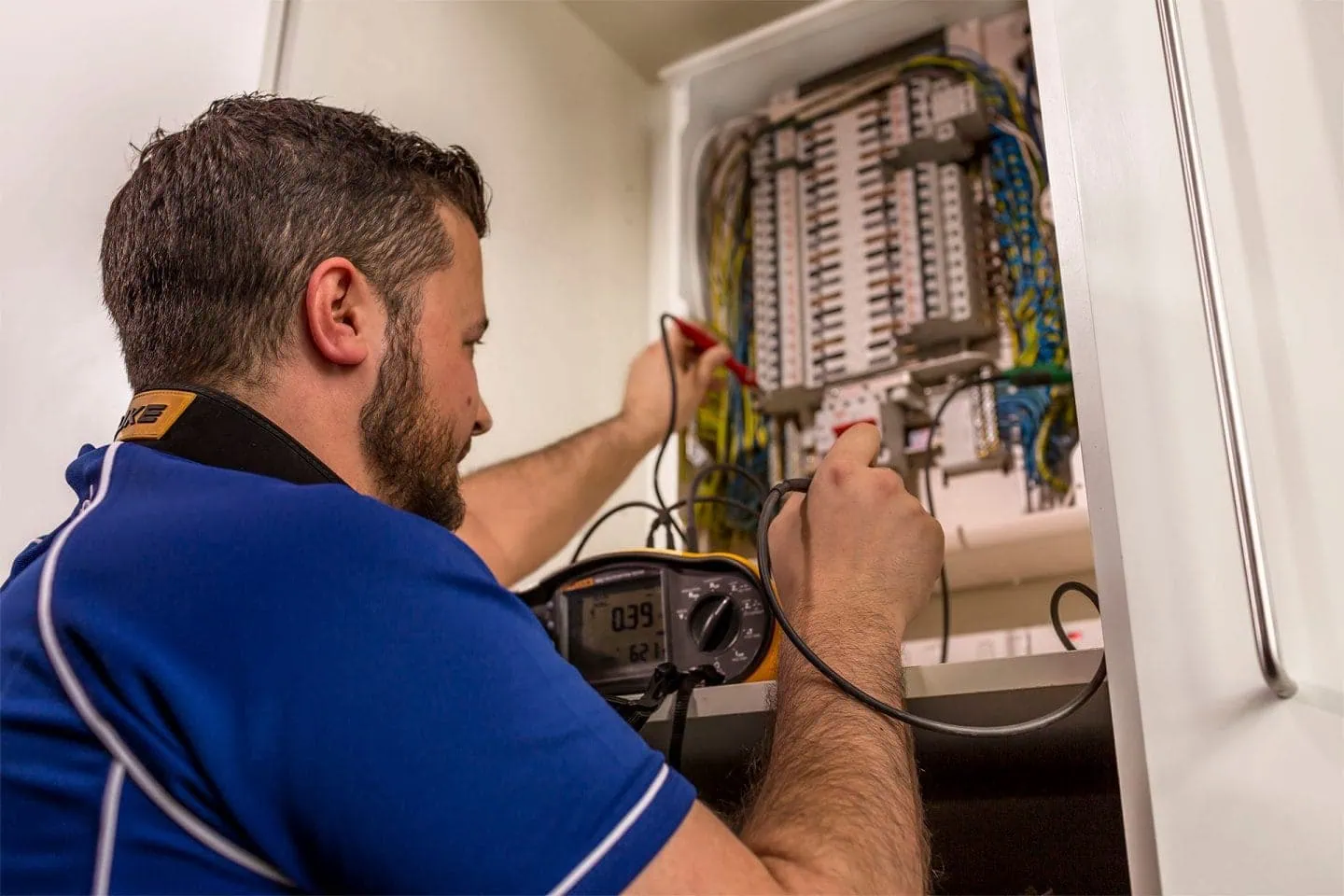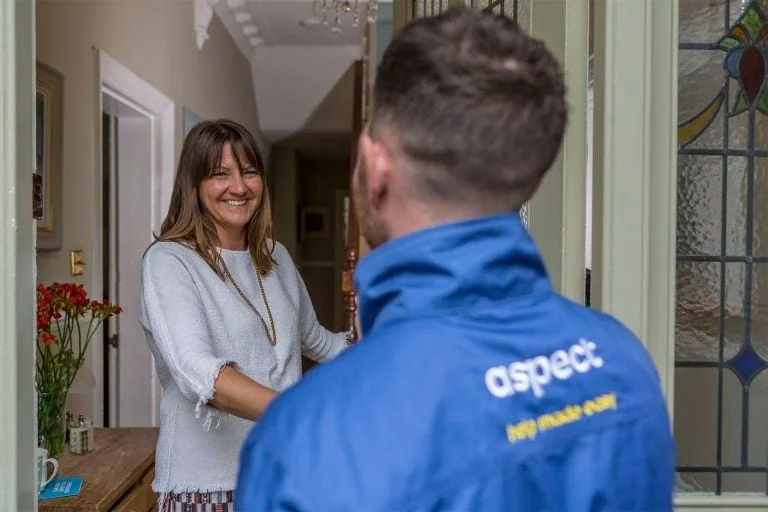What does an electrical safety check involve? What to expect
These days most people recognise the importance of electrical safety checks in their home. However, “What does an electrical safety check involve?” is a question that many homeowners and landlords ask.
That’s why we’ve created this simple breakdown to go through what you can expect during an electrical safety check. Read on to find out what kind of tests are involved, how long they will take, what the possible outcomes are, and also how much we charge for them.

Understanding the purpose of electrical safety checks
An EICR (Electrical Installation Condition Report) is a series of checks done on the fixed wire electrical installation within a property. These checks identify problems early, that could potentially cause fire or electric shocks if left to deteriorate further. When the testing is complete, you are issued with an electrical safety report.
For landlords, the Private Rented Sector (England) Regulations 2020, require that electrical installations in rental properties must be inspected and tested by a competent person at least every 5 years.
For homeowners, although not a legal requirement, it’s highly recommended to carry out an electrical safety check when purchasing a house to identify potentially dangerous issues.
It’s important to remember that all electrical installations degrade over time due to wear and tear, so need to be tested regularly. Improved safety features that come about via regulation changes can also be identified and added.
Book an EICR

Our electricians can conduct an EICR inspection in any residential or commercial property.
- Rates start from £135.00 + VAT for residential
- Rates start from £360.00 + VAT for residential
- Report shared within 2 working days
- Fixed pricing for planned work
What are fixed wire installations?
An electrical safety check involves testing the fixed wire installation in a property. Fixed wire installations refer to several elements present inside a property, including:
- Wiring
- Plug sockets
- Light fittings
- Switches
- Protective bonding
- Consumer unit (fuse box)
NB: Electrical appliances are not checked during an EICR electrical check. Electrical appliances are checked during Portable Appliance Testing (PAT).
How long does an electrical safety check take?
The amount of time an electrical safety check takes will depend on:
- the size of your property
- the number of circuits to be tested
- the complexity of the installation
- any potential issues that are found during the inspection
If you have a previous EICR, giving this to the electrician will help them understand how the installation has been wired, which will therefore save time.
Each circuit on a consumer unit needs to be tested. A percentage of outlets (e.g. switches, sockets, light fittings) on a circuit are tested. If no problems are found the next circuit will then be tested. If problems are found, more outlets might need to be tested, adding more time to the total procedure.
As a general rule, allow up to 30 minutes per circuit.
Testing versus repairs
The process involves a visual inspection, physical testing procedures, and concludes with a report being issued, so the time this takes will naturally vary depending on how many circuits need to be tested.
Repairs are not typically carried out during the testing process. Fault codes are recorded on the report, and any remedial work that’s needed can be carried out after.
The inspection process
The inspection process for an electrical safety check includes the following steps:
1. Visual inspections
During a visual inspection, an electrician inspects an asset or component without the assistance of special equipment. They will search for flaws, defects, damages, or other issues.
To prepare for a visual inspection, landlords and homeowners should:
- Ensure that all electrical outlets and switches are accessible and that any visible wiring is in a satisfactory condition
- Verify that all electrical installations are functioning properly
- Ensure that all outlets are covered and no wires are exposed
2. EICR testing procedures
Following the visual inspection, electricians will carry out tests using voltage testers, circuit testers, and other equipment.
These tests provide an in-depth assessment of the electrical system, allowing electricians to uncover hidden issues or potential hazards that won’t be evident during a visual inspection.
Dead tests check for potential problems in an electrical system. For this part of the inspection, the electrician will need to disconnect the electrical system from the mains power supply. Dead tests include:
- Ring circuit loop impedance: makes sure that the cables form a complete ring without interconnection between the wires, and that the polarity is correct on each outlet
- Insulation resistance: checks that the insulating materials around the conductors (wires) are intact
- Continuity testing: checks for any badly connected wires
Live tests ensure that the electrical system in the property can shut down in the case of a major emergency. Live tests include:
- Polarity testing: ensures that the connections are connected in the right sequence
- Earth fault loop impedance testing: this test will check that, if a fault occurs, the electrical system can disconnect within the necessary time frame
- RCD testing: in more modern electrical fixtures, the RCD (residual current device) will be tested to make sure it’s working correctly. An RCD is a safety device that ensures that anyone who touches something live does not receive an electric shock.
3. Electrical Installation Condition Report (EICR)
After all tests have been done, the electrician will issue an Electrical Installation Condition Report (EICR).
It indicates the condition of the various parts of the electrical installation as either ‘satisfactory’ or ‘unsatisfactory’, and details any observations that may affect safety or require improvements. Additionally, it ensures that the electrical installation is in accordance with the current British Standard for electrical safety (BS 7671).
4. Remedial repair work
On the EICR any faults will be listed. These are there to assess how much risk is present:
- C1 fault code means that danger is present and immediate remedial action is required
- C2 fault code indicates that there is potential danger present and remedial work needs to be done urgently
- C3 fault code means that improvement is recommended
- FI code means a potential issue has been identified, but further investigation is required to determine the severity of the problem
If remedial work or repairs are required on C1 or C2 faults, it’s crucial to address these to ensure the safety of the property’s occupants and also comply with electrical safety regulations.
How we charge for an electrical safety check
For residential properties, we charge a fixed price based on the number of bedrooms, and the number of circuits that need to be tested.
Prices for a studio apartment (up to 6 circuits) start from £135.00 + VAT for a weekday daytime booking, plus £22.50 + VAT for each additional circuit.. For a 3 bedroom property (up to 12 circuits) prices start from £270.00 + VAT for a weekday daytime booking.
For commercial properties, prices start from £360.00 + VAT weekday rate for up to 10 circuits, plus £27.00 + VAT for each additional circuit.
Electrical safety checks can also be done on evenings and weekends, which is charged at a higher rate. However, keep in mind that circuits need to be turned off during testing, so it’s best to schedule an EICR for when this won’t cause disruption.
Areas we cover

As a guide, we offer a comprehensive range of electrical services throughout Greater London and the Home Counties. Our service area includes Berkshire, Buckinghamshire, Essex, Hertfordshire, Kent, and Surrey.
If you need an electrician outside of this coverage area, we may still be able to help. Our team will check availability and see if an expert can be scheduled for your location.
Call or submit a callback request, and a member of our team will be in touch with you.
Was this article helpful?
Think we could improve this article? Please let us know